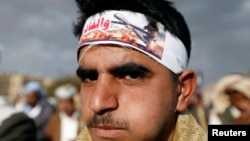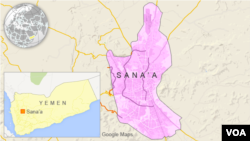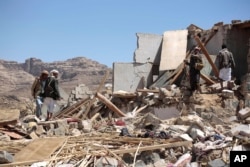They are nicknamed "kamikaze" drones. Houthi forces and those aligned with former President Ali Abdullah Saleh in Yemen are using them to target the missile-defense systems of Saudi-led coalition forces, weapons analysts say.
According to a study by Conflict Armament Research (CAR), a London-based organization funded by the European Union to monitor the movement and use of conventional weaponry, Iran has been supplying Houthi forces and Saleh loyalists with weaponry since the start of the two-year conflict that has left 10,000 civilians dead and an estimated 40,000 injured.
Among the weapons — unmanned aerial vehicles (UAV), which CAR researchers say in their report released Wednesday have been supplied in batches to Houthi and Saleh’s forces.
Topple government
Saudi Arabia intervened in Yemen's civil war in 2015 after Houthis toppled President Abd-Rabbu Mansour Hadi.
Government forces dominate in the south and east of the impoverished country on the tip of the Arabian Peninsula, but Houthis, who are an offshoot of Shi'ite Islam, control the larger towns in the northwest, including the capital, Sana'a.
CAR researchers report that Houthi- and Saleh-aligned forces employ many of the drones to target the Saudi coalition’s Patriot surface-to-air missile systems.
“They do so by crashing the UAVs into the systems’ radar sets (specifically the circular main phased arrays) -- directing the UAVs by programming their systems with open-source GPS coordinates of the Patriots’ positions,” researchers said.
“While the coalition deploys Patriot systems to counter missile threats, the destruction of the Patriots’ radar systems enables Houthi- and Saleh-aligned forces to target coalition assets with volleys of missile fire unhindered,” they added.
The use of these drones illustrates the Houthi- and Saleh-aligned forces’ ability to employ low-cost technology against the coalition’s sophisticated military assets, researchers said.
Military transfers
Military transfers by the Iranians to their allies in Yemen have been stepped up in recent months, according to U.S. and Western officials.
On Tuesday, the Reuters news agency reported that U.S. officials have intelligence indicating Iran has been increasing weapons transfers to the Houthis, mirroring the strategy Tehran has used to support its Lebanese ally, Hezbollah, in Syria.
Iran rejects accusations from Saudi Arabia and the West that it is giving financial and military aid to the Houthis in the battle over Yemen. Tehran blames Riyadh for the intractable conflict.
Last October, U.S. and Western officials highlighted the Iranian weapons transfers, which they said includes a range of weaponry, from small arms to missiles, as well as coastal defense cruise missiles such as ones fired at the USS Mason, an American naval destroyer, three times in October 2016.
Those attacks on the naval destroyer prompted retaliation by the U.S. military, which launched cruise missiles that destroyed three Houthi radar sites.
Vice Admiral Kevin Donegan, head of U.S. Naval Forces Central Command, accused Iran shortly after the attacks on the USS Mason of being connected with the attacks on the ship. And he disclosed that U.S. and partner nations intercepted five seaborne weapons shipments from Iran that were headed to the Houthis.
The CAR researchers say the acquisition of Qasef-1 drones “supports [Western] allegations that Iran continues to bolster the capacity of Houthi- and Saleh-aligned forces through the transfer of new technology and advanced weaponry.”
Weapons transfers are enabling the Houthis and their allies to conduct sophisticated asymmetric operations against the Saudi-led coalition.
Unmanned aerial vehicles
The CAR investigators inspected seven UAVs for their report.
Six were seized on November 27 by Presidential Guards from the Emirates, who intercepted a truck transporting them in Yemen’s Marib province.
The drones were partially assembled. A seventh was recovered after it crashed near Aden International Airport. CAR investigators also examined a damaged drone recovered after a Houthi attack.
The fuselage and wings of the UAVs bore printed serial numbers, corresponding to handwritten serial numbers stamped on various internal components. Some of the serial numbers were consecutive, indicating that the drones were manufactured on the same production line.
Last month, Houthi forces displayed four UAVs, which they claimed to have designed and manufactured themselves.
One of the systems displayed is identical to the UAVs produced by Iran’s Aircra Manufacturing Industrial Company, the CAR investigators said.
Brigadier General Ahmed Asseri, a spokesman for the Sunni Arab coalition fighting the Houthis, told Reuters, "We don't lack information or evidence that the Iranians, by various means, are smuggling weapons into the area.”
Saudi military officials say that many of the weapons systems being used by the Houthis now were not in the arsenals of the Yemeni army, which the Houthis plundered in the first months of the conflict.
Many of the Iranian weapons are being transported overland through Yemen’s neighbor Oman, Saudi officials said. Oman denied the claim.










